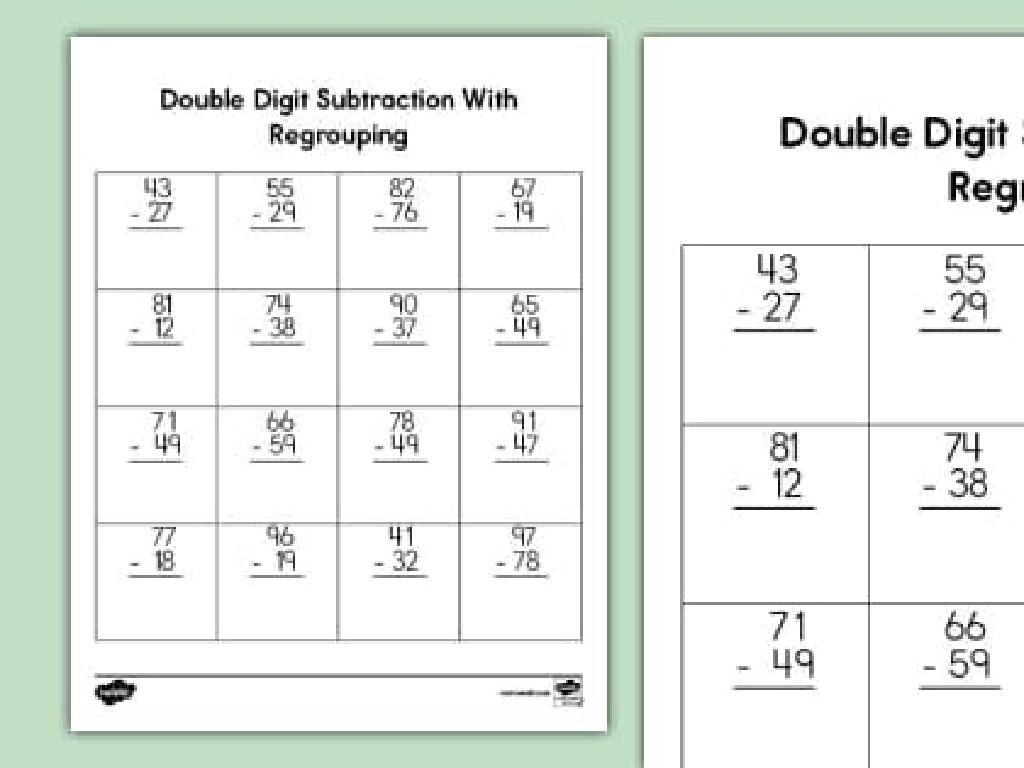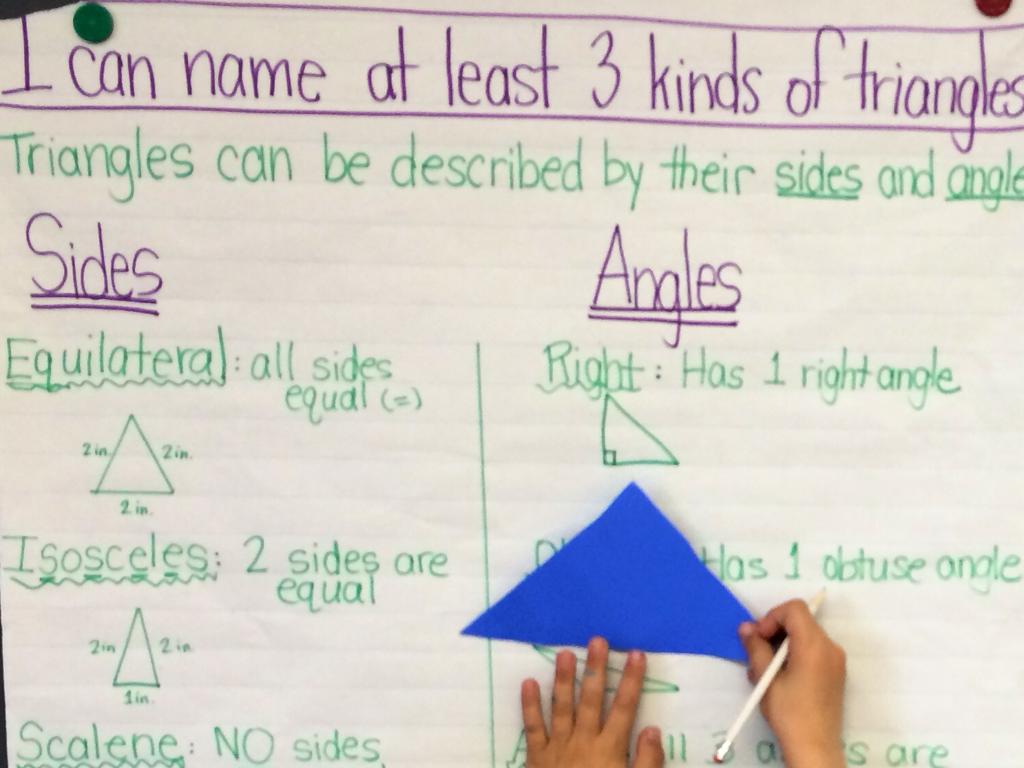Add And Subtract Mixed Numbers: Word Problems
Subject: Math
Grade: Seventh grade
Topic: Operations With Fractions
Please LOG IN to download the presentation. Access is available to registered users only.
View More Content
Introduction to Mixed Numbers
– Understanding fractions & whole numbers
– Fractions represent parts of a whole, while whole numbers are complete units.
– Defining mixed numbers
– Mixed numbers combine whole numbers with fractions, like 2 1/2.
– Mixed numbers in daily life
– Common in cooking (1 3/4 cups of flour) or measuring (5 1/2 feet tall).
– Practice with real examples
– Solve problems using mixed numbers from everyday scenarios.
|
This slide introduces the concept of mixed numbers, which are essential in understanding operations with fractions. Begin by explaining the difference between fractions and whole numbers, ensuring students are comfortable with each concept separately. Then, define mixed numbers as the sum of a whole number and a fraction, which is a common occurrence in real-life situations such as cooking or measuring. Provide relatable examples to help students visualize the concept. Encourage students to think of their own examples where they encounter mixed numbers. Conclude with a few practice problems that involve adding or subtracting mixed numbers, drawn from everyday contexts, to reinforce the lesson.
Visualizing Mixed Numbers
– Use number lines for mixed numbers
– Number lines help us see the value of whole numbers and fractions combined.
– Convert improper fractions
– Change fractions greater than the denominator into a mixed number.
– Identify mixed numbers practice
– Find and write down mixed numbers from homework exercises.
– Understanding through visualization
|
This slide aims to help students visualize mixed numbers using number lines, which can make understanding these numbers more intuitive. Emphasize the importance of the whole number and the fraction part of a mixed number. Show how to convert improper fractions (where the numerator is larger than the denominator) into mixed numbers by dividing to find the whole number and then the remaining fraction. Provide practice problems for students to identify mixed numbers from a set of numbers. Use visual aids like number lines drawn on the board or printed worksheets to enhance comprehension. Encourage students to ask questions if they’re unsure about how to convert or identify mixed numbers.
Adding Mixed Numbers
– Steps to add mixed numbers
– Convert to improper fractions, find common denominators, add and simplify.
– Example with like denominators
– 2 1/4 + 3 1/4 = 5 2/4, which simplifies to 5 1/2.
– Example with unlike denominators
– 3 2/5 + 4 1/3 = 3 6/15 + 4 5/15 = 7 11/15.
|
This slide introduces students to the process of adding mixed numbers, which is a key skill in working with fractions. Start by explaining the steps to convert mixed numbers to improper fractions, find a common denominator, and then add the fractions together. After adding, the result should be simplified if possible. Provide an example with like denominators to show the straightforward addition, and then with unlike denominators to demonstrate finding a common denominator. Encourage students to practice these steps with additional problems and ensure they understand how to simplify their answers.
Subtracting Mixed Numbers
– Steps to subtract mixed numbers
– Convert to improper fractions, find common denominators, subtract, simplify.
– Example with like denominators
– 3 1/4 – 2 1/4: Same denominator, just subtract the whole numbers and fractions separately.
– Example with unlike denominators
– 5 2/3 – 3 1/6: Different denominators, find a common one, convert, subtract, and simplify.
– Practice problem set
|
This slide introduces the concept of subtracting mixed numbers, a key skill in understanding operations with fractions. Start by explaining the steps to convert mixed numbers to improper fractions, finding a common denominator, and then subtracting and simplifying the result. Provide an example with like denominators to show a simpler case, then move on to an example with unlike denominators, which requires finding a common denominator before subtracting. Conclude with a set of practice problems for students to apply what they’ve learned. Ensure to walk through the examples step by step, and encourage students to ask questions if they’re unsure about the process.
Word Problems: Mixed Numbers
– Comprehend the problem’s context
– Read carefully to grasp the scenario.
– Highlight crucial numerical data
– Look for and underline all numbers and units.
– Add and subtract mixed numbers
– Use addition or subtraction with mixed numbers as needed.
– Apply steps to solve word problems
– Follow a systematic approach: understand, plan, solve, and check.
|
This slide aims to guide students through the process of solving word problems that involve adding and subtracting mixed numbers. Start by ensuring students understand the context of the problem, which will help them determine the operation to use. Teach them to identify and highlight key information, such as the numbers involved and what they represent. Demonstrate how to perform addition and subtraction with mixed numbers, possibly by converting them to improper fractions and then back to mixed numbers if necessary. Emphasize the importance of a step-by-step approach to solving word problems: understanding the problem, planning how to solve it, carrying out the solution, and finally checking their work. Provide examples and encourage students to practice with problems of varying complexity.
Class Activity: Mixed Numbers Challenge
– Pair up and solve word problems
– Share solutions with the class
– Discuss methods used
– Explore various approaches
|
This activity is designed to promote collaborative learning and problem-solving skills. Students will work in pairs to tackle word problems involving the addition and subtraction of mixed numbers. After solving the problems, each pair will share their solutions and the strategies they used with the rest of the class. This will be followed by a group discussion where different approaches are compared and contrasted. As a teacher, facilitate the discussion by highlighting different methods, ensuring that students understand why certain solutions work, and addressing any misconceptions. Provide at least four to five different word problems of varying difficulty to cater to different skill levels within the class. Encourage students to think critically about the efficiency and effectiveness of different strategies.
Review: Adding & Subtracting Mixed Numbers
– Recap key points of mixed numbers
– Remember to convert to improper fractions and find a common denominator.
– Discuss common mistakes
– Don’t forget to simplify your answers, and ensure proper fraction form.
– Quick quiz to test understanding
– A five-question quiz will reinforce today’s concepts.
– Encourage questions and discussions
|
This slide aims to consolidate the students’ knowledge on adding and subtracting mixed numbers. Start by reviewing the steps for converting mixed numbers to improper fractions and finding a common denominator, which is crucial for performing these operations. Highlight common mistakes, such as not simplifying the final answer or mixing up the numerators and denominators. Conduct a quick quiz to assess the students’ grasp of the lesson. Use this opportunity to clarify any doubts and encourage students to discuss the problems they found challenging. This interactive session will help students reflect on what they’ve learned and prepare them for more complex problems.
Homework: Mastering Mixed Numbers
– Practice adding & subtracting mixed numbers
– Solve real-world mixed number problems
– Use scenarios like cooking or measuring
– Review solutions for accuracy
– Check work with a peer or use a calculator
– Preview: Multiplying mixed numbers
– Understand the concept before next class
|
This homework assignment is designed to reinforce students’ understanding of adding and subtracting mixed numbers through practice problems. Encourage them to apply these skills to real-world situations, such as cooking or measuring, to make the problems more relatable. Students should review their solutions to ensure accuracy, possibly by checking with a peer or using a calculator. Additionally, provide a brief introduction to multiplying mixed numbers to prepare them for the upcoming lesson. Offer various problem sets to cater to different skill levels and ensure that all students are challenged appropriately. The goal is to build confidence and proficiency in working with mixed numbers.





